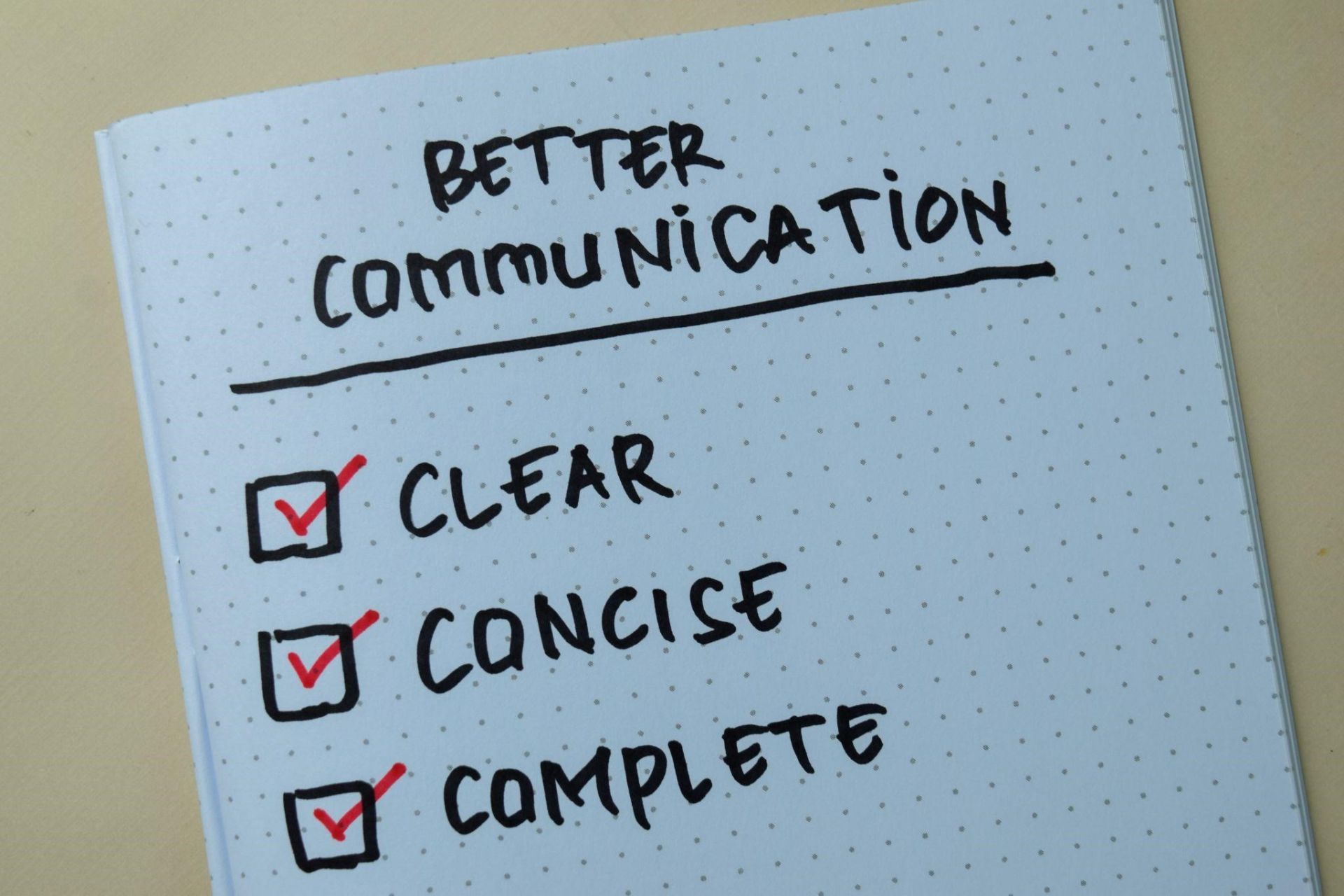Developing Effective Communication Skills in Any Setting
Advance your career with professional communication skills. From effective strategies to practical examples, learn how to convey your message clearly and confidently with Teamioed.
Charlotte Barber, BCs, PGC, BABCP®
Effective communication is more
than just exchanging information; it's about ensuring your message is heard,
understood, and felt. Whether through words, actions, or silence, it's the
bridge that connects us to others.
In the modern workplace and in personal interactions,
the ability to communicate effectively is more than just a valuable skill—it's
essential.
What does effective
communication really entail?
Despite its seemingly instinctive nature,
achieving effective communication is a skill—one that demands not just the
ability to articulate ideas but also to actively listen and accurately
interpret the emotions and intentions behind the words.
Studies underscore its importance, revealing that a significant majority of workplace failures stem from communication breakdowns, highlighting the critical need for good communication skills across all spheres of life.
Whether it's fostering stronger relationships at home, enhancing teamwork and problem-solving at work, or navigating the complexities of digital platforms, the art of communicating effectively shapes our interactions and outcomes, making it imperative to continually refine our communication techniques.
In doing so, we not only bridge the gap between intent and perception but also unlock the door to deeper connections, improved collaboration, and a heightened sense of community and understanding in an increasingly interconnected world.
Studies underscore its importance, revealing that a significant majority of workplace failures stem from communication breakdowns, highlighting the critical need for good communication skills across all spheres of life.
Whether it's fostering stronger relationships at home, enhancing teamwork and problem-solving at work, or navigating the complexities of digital platforms, the art of communicating effectively shapes our interactions and outcomes, making it imperative to continually refine our communication techniques.
In doing so, we not only bridge the gap between intent and perception but also unlock the door to deeper connections, improved collaboration, and a heightened sense of community and understanding in an increasingly interconnected world.
Did You Know?
Companies with effective communication practices
can see up to 50% higher returns to shareholders. This statistic underscores
the tangible impact of mastering communication skills.
The 5 Cs of Effective Communication: A Closer Look
Effective communication hinges on five key
principles: clarity, correctness, completeness, conciseness, and compassion.
Here’s how you can apply them:

- Clarity: How clear is your message? Aim for simplicity to avoid misunderstandings.
- Correctness: Is your information accurate and error-free?
- Completeness: Have you provided all the necessary information?
- Conciseness: Can you convey your message in fewer words without losing its essence?
- Compassion: Are you considering the emotional tone and impact of your message?
Why is Effective Communication Paramount?
- Builds Strong Relationships: Whether in personal life or at work, good communication is the foundation of strong relationships.
- Enhances Team Productivity: Clear communication at work leads to increased understanding, fewer mistakes, and higher productivity.
- Promotes Problem-Solving: Effective communication skills are crucial for resolving conflicts and finding mutually beneficial solutions
Try out a FREE team course and see how you and your team can reach whole new levels of performance. Simply click here to get started!
Real-World Impact: Communication Success Stories
- Tech Titans: A leading tech company implemented weekly transparent updates from leadership, resulting in a 25% productivity boost.
- Healthcare Heroes: A healthcare provider's introduction of patient-centric communication training significantly improved patient satisfaction.
Engaging Your Audience: Questions to Consider
- How effectively do you think you communicate?
- What steps can you take today to improve your communication skills?
- Can you recall a situation where effective communication made a difference?
The Foundation of Effective Communication
- Elaborate on the necessity of understanding your audience, incorporating "communication skill" and "communications skills".
- Add statistics about audience engagement and examples of successful messaging tailored to different groups.
Practical Ways to
Improve Your Communication Skills

Audience Consideration:
- Highlight the importance of "clear communication" and "communicate effectively" with examples from marketing campaigns and personal interactions.
- Use bullet points to list tips for audience analysis.
Active Listening:
- Provide actionable steps and examples, such as "other words for effective" communication strategies in listening.
- Include a sidebar with statistics on how active listening improves communication outcomes.
Feedback Incorporation:
- Discuss the role of feedback in "good communication skills" and how to use it to "communicate effectively".
- Present case studies or testimonials demonstrating the transformation in communication strategies.
Expanding Your Communication Toolbox
- Introduce advanced "communication techniques" with examples from business, education, and personal scenarios.
- Include infographics showing the effectiveness of various communication methods.
The Impact of Digital Tools on Communication
- Explore how digital platforms enhance "communication at work" and in personal settings, with a focus on "how to communicate effectively".
- Offer insights into the latest communication tools and apps, supported by data on user engagement and satisfaction.
What Stops Us From Communicating Effectively?
The Impact of Stress and Emotional Overwhelm
- When overwhelmed by stress or emotions, our ability to read others and convey our thoughts clearly can be significantly hindered.
- In fact, a study by the American Psychological Association shows that high stress levels can lead to communication breakdowns in over 30% of interactions.
The Multitasking Myth: A Barrier to Focus
- In our attempt to juggle multiple tasks, effective communication often takes a hit.
- Research indicates that multitasking can reduce productivity by as much as 40%.
Inconsistent Body Language: Sending Mixed Signals
- Our nonverbal cues should align with our words. A classic example of conflicting signals is saying "yes" while shaking your head no, which can cause confusion and mistrust.
The Power of Positive vs. Negative Body Language
- Negative body language, such as crossed arms or avoided eye contact, can inadvertently put others on the defensive, even if that's not our intention.
Transforming Barriers into Bridges: Techniques and Strategies
- Active Listening: Engage with the speaker, show empathy, and provide feedback that shows you truly understand their perspective.
- Clear and Concise Messaging: Keep your communication straightforward and to the point to avoid misunderstandings.
- Empathetic Engagement: Try to see the situation from the other person's viewpoint, acknowledging their feelings and perspectives.
- Feedback Loops: Encourage and provide constructive feedback to ensure the message is understood as intended.
The Importance of Effective Communication
- Building Strong Relationships: Effective communication fosters mutual understanding and trust, laying the foundation for strong relationships in the professional arena.
- Enhancing Team Efficiency: Clear communication transforms groups into cohesive teams, streamlining workflow and boosting productivity.
- Fostering Innovation: A culture of open communication encourages innovation, allowing teams to leverage diverse ideas and perspectives.
- Improving Accountability: When communication is clear, individuals are more likely to take responsibility, enhancing the overall effectiveness of processes and teams.
Effective Communication in Everyday Life
- Creating Connections: At the heart of every strong relationship is effective communication, which brings people together and helps maintain bonds.
- Promoting Trust and Understanding: Clear and open communication is essential for building trust and ensuring messages are understood as intended.
- Encouraging Innovation: When people feel heard, they're more likely to contribute innovative ideas, driving productivity and creativity.
How to Communicate Effectively
- Understanding Communication Techniques: Explore how various communication techniques can be adapted to different contexts to ensure your message is received as intended.
- Developing Good Communication Skills: Practical tips and exercises to enhance your ability to communicate clearly and effectively.
- Leveraging Communication Tools: An overview of digital and traditional tools that can aid in enhancing communication effectiveness in the workplace.
Key Strategies for Effective Communication
- Listen Actively: Understand the importance of listening as a fundamental aspect of effective communication.
- Speak Clearly and Concisely: Learn how to convey your messages straightforwardly and understandably.
- Embrace Feedback: Discover how feedback can be a powerful tool for improving communication skills and building stronger connections.
The Impact of Effective Communication on Business Growth
- Driving Team Performance: Insight into how communication serves as the backbone of high-performing teams.
- Enhancing Customer Satisfaction: Explore the direct link between clear communication and improved customer experiences and satisfaction.
- Fostering a Positive Workplace Culture: The role of effective communication in creating a positive and productive work environment.
Real-world Examples
- Case Studies: Highlighting successful companies that have leveraged communication to achieve remarkable results.
The Essence of Effective Communication
Communication plays a pivotal role in all facets of a business. It’s essential for managing employee expectations, building cohesive teams, driving organizational growth, establishing trust, spurring creativity and innovation, and minimizing misunderstandings.
1. Navigating Employee Management with Good
- Expectation Setting: Clearly articulating job roles and expectations, ensuring everyone is on the same page.
- Feedback: Providing constructive feedback to encourage professional growth and improve performance.
- Understanding Personal Goals: Engaging in open dialogue to align individual aspirations with organizational objectives.
2. Fostering Team Building Through Clear Communication
- Boosting Morale: Enhancing team spirit by ensuring all members are aligned with the company’s vision.
- Acknowledging Achievements: Recognizing individual contributions to motivate and sustain team effort towards common goals.
3. Driving Organizational Growth with Effective Communication Techniques
- Eliminating Delays: Streamlining policy implementation and operational processes.
- Enhancing Productivity: Improving efficiency and output, contributing to the overall growth and profitability of the company.
4. Building Strong Relationships and Trust
- Encouraging Positive Interactions: Promoting healthy communication to build and maintain robust working relationships.
- Ensuring Transparency: Keeping lines of communication open to build trust within the organization and with external stakeholders.
5. Cultivating Creativity and Innovation
- Openness to New Ideas: Creating an environment where employees feel comfortable sharing innovative thoughts.
- Integration of Creative Solutions: Encouraging a culture that embraces new ideas for the company's betterment.
6. Reducing Misunderstandings with Clear Communication
- Clarifying Messages: Ensuring that communication is straightforward to prevent potential conflicts and confusion.
- Enhancing Understanding: Developing communication skills to bridge gaps between different levels of the organization.
7. Contributing to Organizational Excellence
- Improving Information Flow: Making sure that all messages, data, and directives are communicated efficiently and effectively.
- Fostering Goodwill: Building a positive reputation among customers through clear and honest communication.
Key Takeaways
- What makes good communication skills so vital in today’s business landscape?
- How can effective communication definition guide us in improving our workplace interactions?
- In what ways do communication techniques contribute to the effectiveness of organizational processes?
By embracing the principles of communication, businesses can unlock a wealth of benefits, from enhanced employee engagement to increased operational efficiency and customer satisfaction.
It’s not just about transmitting information but about creating a dialogue that bridges gaps, builds trust, and drives forward momentum.
The Essential Elements of Effective Communication
Understanding the process of
effective communication is pivotal. Here are the key components that facilitate
clear and successful exchanges:
- Sender: The communication journey begins with the sender. This is the individual who initiates the conversation, crafting and encoding the message to be shared. The sender's role is critical, as they lay the groundwork for the message's clarity and effectiveness.
- Message: What are you trying to say? The message encompasses the ideas, thoughts, and information the sender wishes to convey. It's essential that this message is clear and concise to ensure the receiver can understand it as intended.
- Encoding: This is the process of transforming thoughts into communicable messages. Encoding can involve verbal speech, written text, or nonverbal cues like body language. The effectiveness of communication heavily relies on the sender's ability to encode their message appropriately.
- Channel: How is your message being delivered? The channel - whether face-to-face, over the phone, via email, or through social media - plays a significant role in the message's reception and interpretation.
- Receiver: The receiver is the target audience of the message. Effective communication requires active listening and understanding from the receiver to accurately decode the message.
- Decoding: Upon receiving the message, the receiver interprets or decodes it. Successful decoding depends on the receiver's ability to understand and process the information correctly.
- Feedback: The final step in the communication process, feedback, is the receiver's response to the message. This step is crucial for confirming that the message was understood as intended and for making any necessary adjustments.
Enhancing Your Communication Skills: Practical Tips and Techniques

- Active Listening: Engage fully in the conversation, giving the speaker your undivided attention and acknowledging the message received.
- Clear and Concise: Keep your messages straightforward and to the point to avoid misunderstandings.
- Nonverbal Cues: Pay attention to body language, facial expressions, and tone of voice to convey and understand messages more effectively.
- Feedback: Provide constructive feedback and encourage it from others to improve understanding and relationships.
- Empathy: Understanding the feelings and viewpoints of others can greatly enhance communication effectiveness.
In conclusion, the essence of communication lies not just in the transmission of information, but in the meaningful exchange of ideas, emotions, and intentions.
By understanding and implementing the core elements of the communication process—sender, message, encoding, channel, receiver, decoding, and feedback—we can significantly enhance our ability to communicate effectively.
Whether it's through improving our communication skills, employing clear communication techniques, or understanding the importance of communication at work, embracing these principles can lead to more productive interactions, stronger relationships, and a deeper connection with those around us.
Remember, good communication is the bridge between confusion and clarity, and by committing to develop these essential skills, we empower ourselves to navigate the complexities of human interactions with grace and effectiveness.
Let's make every effort to master the art of communication, transforming every conversation into an opportunity for growth and connection.
Explore
Legal notice: Teamioed
Limited is a limited company registered in England with registered number
14441318. Our registered office is at Suite 2453 Unit 3a, 34-35 Hatton Garden,
London, United Kingdom, EC1N 8DX. For information about how we process data and
monitor communications please see our Privacy policy and for terms of use
please see our Terms and Conditions. Our
website has been prepared for general information only and you should always
obtain professional or specialist advice before taking any action on the basis
of the content of our website or our products or services. No rights are to be derived from any proposal contained on
our website and a licence cannot be deemed granted by us until a written
agreement containing all necessary terms and conditions is fully negotiated and
executed between the relevant parties.
All logos and trademarks are the property of their respective owners and are used for informational purposes only. We are not affiliated with, endorsed by, or sponsored by any of the companies represented by these logos.
All logos and trademarks are the property of their respective owners and are used for informational purposes only. We are not affiliated with, endorsed by, or sponsored by any of the companies represented by these logos.
© Teamioed 2025
Secured with SSL

Write your awesome label here.
Write your awesome label here.

